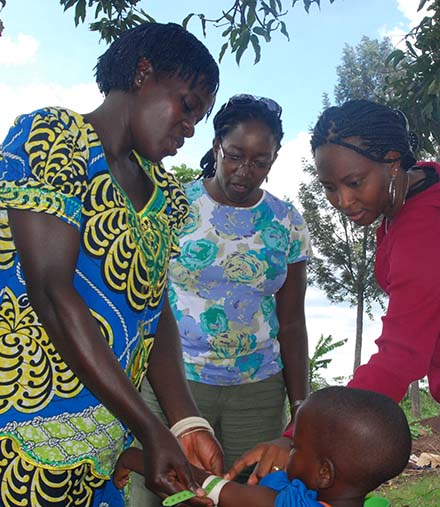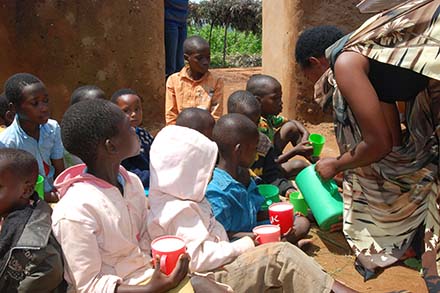
Editor's note: International Women's Day is Sunday, March 8. The theme this year is #MakeItHappen, celebrating the achievements of women everywhere in whatever field they pursue. Follow along as we higlight some of the women we work with who are feeding their families, becoming small business owners and educating their children, among a host of other achievements.
Heifer Rwanda project participants Alphonsine Uwamahoro, Charlotte Musabyimana and Esperance Uwanyiligira have used their positions as milk producers to go beyond sharing and caring for their families to fight against malnutrition of their neighborhood children.
The United Nations Children’s Fund, commonly known as UNICEF, defines malnutrition as a broad term for both eating too much (over nutrition) and not eating enough (under nutrition). According to UNICEF, “People are malnourished if their diet does not provide adequate calories and protein for growth and maintenance or they are unable to fully utilize the food they eat due to illness.”
In 2013, the World Food Program reported that 43 percent of rural Rwandan children under 5 years of age were chronically malnourished.
In response, Alphonsine, Charlotte and Esperance took their corners, offering a total of 152 gallons of cow and goat milk from their yearly collections to battle malnutrition.
Help end malnutrition and provide basic needs to families.
In the Eastern Province, Charlotte has fed 56 malnourished children with the 51 gallons of goat’s milk, 9 percent of her yearly production, she shares with her neighborhood. Charlotte’s home constantly bustles as children walk in and out to drink their daily “gift.”

Goat’s milk is highly nutritious. It can be easier to digest than cow’s milk for people with sensitive digestive systems, and research also indicates it is better for people who are lactose intolerant.
Charlotte’s efforts attracted support from a local health program at the Gituku Health Center. The center is currently providing Charlotte’s group with training material and additional supplies of nutritious food to help in the fight against malnutrition. During the past six months, the local health program gave each malnourished child a package that included about 3 gallons of milk, about 15 pounds of cereal flour and about 13 pounds of legumes, nuts and oil.
Alphonsine donates about 63 gallons, or 5 percent, of yearly production to fight malnutrition in the Northern Province where she lives. In addition to her own five children, she supports 18 children from her daily milk supply that would have otherwise earned her $35 a month.
When asked why she gives away the milk, Alphonsine smiled and said, “I just can’t help it—I have been given a gift and it is all worth it when I see these children looking healthy, like my own children.”
Esperance, a single mother of five, joined the fight by offering 38 gallons, or 3 percent, of her yearly cow milk production. She offers two quarts a day to two families living near her in Mukarange Sector of Kayonza District. Esperance insists that her cow, which she named “Chance,” has brought many blessings into her life and that is why she chooses to share her milk.
Esperance also built a 3-foot deep compost pit in which she processes manure for her neighbors free of cost. The manure collected by her neighbors would have otherwise earned her $62 a month.
Community leaders have repeatedly commended Heifer Rwanda for the compassion exhibited by its project participants in sharing milk and resources with their communities.
Story by Madame Mutera
Photos by Alphonsine Uwamahoro